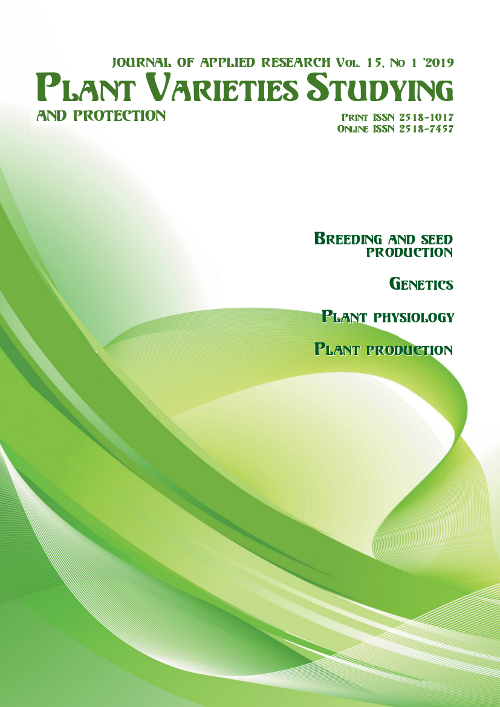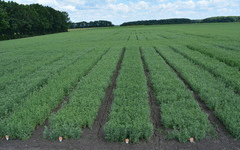Investigation of the impact of Lupinus angustifolius L. flour on the rheological properties of wheat flour dough
DOI:
https://doi.org/10.21498/2518-1017.15.1.2019.162487Keywords:
Lupinus angustifolius L., rheological properties of the test, proportion impact of the factor, coefficient of correlationAbstract
Purpose. To investigate the patterns of changing the rheological properties of the dough and laboratory baking, depending on the amount of flour from different varieties of lupine added to wheat flour.
Methods. The baking quality was analyzed using an alveograph and farinograph.
Results. Based on the evaluation of alveograph, farinograph and laboratory bread baking, the patterns of changing the rheological properties of the dough when adding lupine flour to wheat flour were determined. The share of lupine variety’s influenced on flour strength, elasticity and stretchability of the dough, elasticity index ranged from 1 to 4%, with flour concentration – 82–98%. On the basis of the obtained data of the regression equation for the dependencies between the alveographer parameters and the amount of lupine flour added to wheat one were determined. A linear relationship was established between the physical characteristics of dough and the concentration of lupine flour. The proportion of the lupine variety impact on the time of dough formation, rate of dough fluidizing, valorimetric estimation of the flour mixture was 4–18%, the concentration of lupine flour was 57–76%. The bread loaf volume was for 86% determined by the concentration of lupine flour and for 6% by lupine variety. Based on the regression equations between the physical properties of the dough and the concentration of lupine flour, an exponential, linear, and polynomial dependence were found. The linear dependence was revealed between the bread loaf volume and the concentration of lupine flour in a lupine-wheat mixture.
Conclusions. The rheological properties of the dough, as well as the bread loaf volume, were most influenced by the concentration of lupine flour in lupine-wheat flour mixture (57–98%). The share of influence on these indicators of lupine varieties used in the study did not exceed 18%. The revealed regression equations between the concentration of lupine flour and the physical characteristics of the dough allow predicting their changes depending on the amount of lupine flour added to wheat flour.
Downloads
References
Anisimova, L. V., & Ahmed, S. O. I. (2017). Rheological properties of dough from a mixture of wheat flour and whole oat flour. Polzunovskij vestnik [Polzunovsky vestnik], 3, 9–13. [in Russian]
Boldina, А. (2014). Using rice flour as a dietary supplement and studying its effect on the rheology of dough. Khranenie i pererabotka zerna [Grain Storage and Processing], 7, 49–51. [in Russian]
Dotsenko, V. F., Miroshnik, Yu. A., Shidlovskaya, E. B., & Medvid, I. M. (2014). Studying possibility of using fruit powders in technology of sponge-cake semi-finished products. East.-Eur. J. Enterp. Technol., 3(10), 64–69. doi: 10.15587/1729-4061.2014.24885 [in Russian]
Kohajdová, Z., Karovičová, J., & Schmidt, Š. (2011). Lupin composition and possible use in bakery – a review. Czech J. Food Sci., 29(3), 203–211. doi: 10.17221/252/2009-CJFS
Corrao, A. (1979). Grapeseed as a possible source of food protein. J. Am. Oil Chem. Soc., 56(3), 460. doi: 10.1007/BF02671540
Paraskevopoulou, A., Provatidou, E., Tsotsiou, D., & Kiosseoglou, V. (2010). Dough rheology and baking performance of wheat flour–lupin protein isolate blends. Food Res. Int., 43(4), 1009–1016. doi: 10.1016/j.foodres.2010.01.010
Bilgiçli, N., & Levent, H. (2014). Utilization of lupin (Lupinus albus L.) flour and bran with xylanase enzyme in cookie production. Legume Res., 37(3), 264–271. doi: 10.5958/j.0976-0571.37.3.040
Al Omari, D. Z., Abdul-Hussain, S. S., & Ajo, R. Y. (2016). Germinated lupin (Lupinus albus) flour improves Arabic flat bread properties. Qual. Assur. Saf. Crop. Food., 8(1), 57–63. doi: 10.3920/QAS2014.0441
Villarino, C. B. J., Jayasena, V., Coorey, R., Chakrabarti-Bell, S., Foley, R., Fanning, K., & Johnson, S. K. (2015). The effects of lupin (Lupinus angustifolius) addition to wheat bread on its nutritional, phytochemical and bioactive composition and protein quality. Food Res. Int., 76(1), 58–65. doi: 10.1016/j.foodres.2014.11.046
Ratoshniuk, V. I. (2017). Expedience of the use of processing products of non-alkaloid lupin for enhancement of nutritive and biological value of bakery products. Naukovì dopovìdì NUBiP Ukraïni [Scientific reports NULES of Ukraine], 4. Retrieved from http://journals.uran.ua/index.php/2223-1609/article/view/112413/107167 [in Ukrainian]
Ratoshniuk, V. I., & Prysiazhniuk, L. M. (2017). Efficiency of using flour mixture of bread winter wheat and non-alcaloid narrow-leaved lupine in bread-baking technology. Mironìvsʹkij vìsnik [Myronivka Bulletin], 5, 194–204. [in Ukrainian]
Kostenko, N. P., & Lakhtionova, S. O. (2013). Research of new varieties of narrow-leaved lupine (Lupinus angustifolius L.) and white lupine (Lupinus albus L.). Plant Var. Stud. Prot., 3, 26–29. doi: 10.21498/2518-1017.3(20).2013.57437 [in Ukrainian]
Tkachyk, S. O. (Ed.).(2016). Metodyka provedennia kvalifikatsiinoi ekspertyzy sortiv roslyn na prydatnist do poshyrennia v Ukraini. Metody vyznachennia pokaznykiv yakosti produktsii roslynnytstva [Regulations on the procedure and the conduct of qualification tests for suitability of crop varieties for dissemination in Ukraine. Methods of determining quality indices of crop products]. Vinnytsia: FOP Korzun D. Yu. [in Ukrainian]
Ermantraut, E. R., Bobro, M. A., Hoptsii, T. I., Ohurtsov, Ye. M., Prysiazhniuk, O. I., Shevchenko, I. L., … Rozhkov, A. O. (2008). Metodyka naukovykh doslidzhen v ahronomii [Methodology of scientific research in agronomy]. Kharkiv: KhNAU. [in Ukrainian]
Pollard, N. J., Stoddard, F. L., Popineau, Y., Wrigley, C. W., & MacRitchie, F. (2002). Lupin flours as additives: Dough mixing, breadmaking, emulsifying, and foaming. Cer. Chem., 79(5), 662–669. doi: 10.1094/CCHEM.2002.79.5.662
Ahmed, A. R. A. (2012). Technological and Nutritional Studies on Sweet Lupine Seeds and its Applicability in Selected Bakery Products: Doctoral Thesis. Technical University of Berlin, Germany. doi: 10.14279/depositonce-3348
Larchenko, K. A., & Morgun, B. V. (2010). Wheat grain quality traits and methods of their improvement. Fiziol. Biokhim. Kul’t. Rast. [Physiology and Biochemistry of Cultivated Plants], 46(6), 463–474. [in Ukrainian]
Usova, Z. V. (2010). Rheological properties of the dough and baking quality indices of wheat genotypes flour depending on the subunits of high molecular weight glutenins. Selekciâ i nasìnnictvo [Plant Breeding and Seed Production], 98, 196–203. doi: 10.30835/2413-7510.2010.70260 [in Ukrainian]
Abdel-Samie, M. A. S., & Abdulla, G. (2016). Evaluation of sweet lupin seeds flour addition on pan bread qualities. J. Food Dairy Sci., 7(2), 71–79.
Bartkiene, E., Jakobsone, I., Juodeikiene, G., Vidmantiene, D., Pugajeva, I., & Bartkevics, V. (2013). Effect of lactic acid fermentation of lupine wholemeal on acrylamide content and quality characteristics of wheat-lupine bread. Int. J. Food Sci. Nutr., 64(7), 890–896. doi: 10.3109/09637486.2013.805185
Villarino, C. B. J., Jayasena, V., Coorey, R., Chakrabarti-Bell, S., & Johnson, S. K. (2016). Nutritional, health, and technological functionality of lupin flour addition to bread and other baked products: Benefits and challenges. Crit. Rev. Food Sci. Nutr., 56(5), 835–857. doi: 10.1080/10408398.2013.814044
Downloads
Published
How to Cite
Issue
Section
License
Copyright (c) 2019 Ukrainian Institute for Plant Variety Examination

This work is licensed under a Creative Commons Attribution-ShareAlike 4.0 International License.
Starting in 2022, the copyright to the publication remains with the authors
Our journal abides by the CREATIVE COMMONS copyright rights and permissions for open access journals.
Authors, who are published in this journal, agree to the following conditions:
- The authors reserve the right to authorship of the work and pass the first publication right of this work to the journal under the terms of a Creative Commons Attribution License, which allows others to freely distribute the published research with the obligatory reference to the authors of the original work and the first publication of the work in this journal.
- The authors have the right to conclude separate supplement agreements that relate to non-exclusive work distribution in the form in which it has been published by the journal (for example, to upload the work to the online storage of the journal or publish it as part of a monograph), provided that the reference to the first publication of the work in this journal is included.

























 Ukrainian Institute for Plant Varieties Examination
Ukrainian Institute for Plant Varieties Examination  Селекційно-генетичний інститут
Селекційно-генетичний інститут Institute of Plant Physiology and Genetics of the National Academy of Sciences of Ukraine
Institute of Plant Physiology and Genetics of the National Academy of Sciences of Ukraine
 The National Academy of Agrarian Sciences of Ukraine
The National Academy of Agrarian Sciences of Ukraine